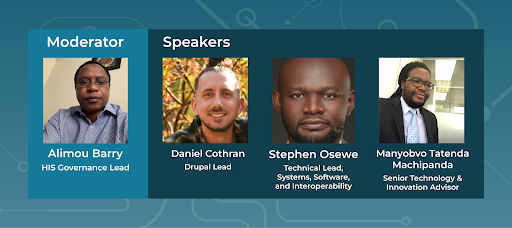You’re trying to improve your country’s national-level health information system (HIS), but first you want to know its current status—and set goals for its future use from there. What can you do?
You can conduct an HIS Stages of Continuous Improvement (SOCI) assessment, and use CHISU’s recently launched HIS Stages of Continuous Improvement (SOCI) online toolkit to continually monitor your progress toward the goals you set in previous HIS SOCI assessments.
To inform those working on their country’s HIS with insights and practical guidance on using the HIS SOCI tool, CHISU hosted a webinar on November 20 titled “Unleashing the Power of the HIS Stages of Continuous Improvement Tool.”
The panel discussion was moderated by Dr. Mamadou Alimou Barry, CHISU HIS Governance Lead. Other presenters included:
- Stephen Osewe, CHISU Technical Lead, Systems, Software, and Interoperability
- Daniel Cothran, CHISU Drupal Lead
- Manyobvo Tatenda Machipanda, CHISU Senior Technology & Innovation Advisor

Osewe spoke about the HIS SOCI assessment, why to use it, and covered the different domains and stages of the assessment.
“Having a baseline, understanding where you are with your HIS and making a plan, and then monitoring that plan and ensuring the plan is meeting your needs is very important in HIS strengthening,” Osewe said.
According to the HIS SOCI website, the assessment measures the status and offers opportunities to set goals of an HIS across five stages, identifies gaps, and supports the development of roadmaps to improve HIS capabilities related to processes, people, and systems essential for achieving a country’s health goals.
Anyone involved in assessing a country’s HIS—whether they are individuals within ministries of health, HIS units, governing bodies and authorities, or nongovernmental organizations—can benefit from using the HIS SOCI assessment.
There are five domains (or components of HIS systems) that the HIS SOCI assessment looks at: leadership and governance; management and workforce; information and communications technology (ICT) infrastructure; standards and interoperability; and data quality and use. Across these five domains, there are 13 components and 39 subcomponents.
While completing the HIS SOCI assessment, there are also five improvement stages that help you see the current status of your HIS and measure progress towards achieving your goals:

Cothran provided a live demonstration of the HIS SOCI website, showing how the tool can make the implementation process easier by automating some steps and allowing users to capture, organize, store, and visualize data.
“I want to emphasize that the website is an online tool for completing the SOCI process. It’s not the process itself,” Cothran said. “The work of the SOCI—and I would actually say the hardest work—is completed in person, or at least outside of the website itself. It involves organizing a prestigious group of participants, seeking evidence from dense government documents, analyzing the evidence according to the scale that has been presented to produce the score, finding consensus among participants and then prioritizing actions.”
Machipanda and Barry spoke about some best practices for using the HIS SOCI assessment tool. One theme in the best practices they discussed was ensuring that you have enough time for the assessment and not rushing it.
Other themes that they discussed included the importance of early planning through establishment of a leadership team and agreement on the assessment scope and approach; ensuring high attendance and full participation by organizing a one-time workshop (rather than holding several sessions over an extended period of time) to retain key HIS experts; seeking consensus building through a multi-step process for scoring and gathering strong evidence; and prioritizing HIS interventions in two steps (within and across domains) and using prioritization matrices.
“It is important to share your experience after you’ve finished doing your SOCI,” Machipanda said. “It is important to share and upload the results you have and build the display on the reports section, or just to share your experience with any other colleagues or any other people who are in the HIS environment.”
Visit the online HIS SOCI assessment tool to learn more and start your HIS SOCI assessment.